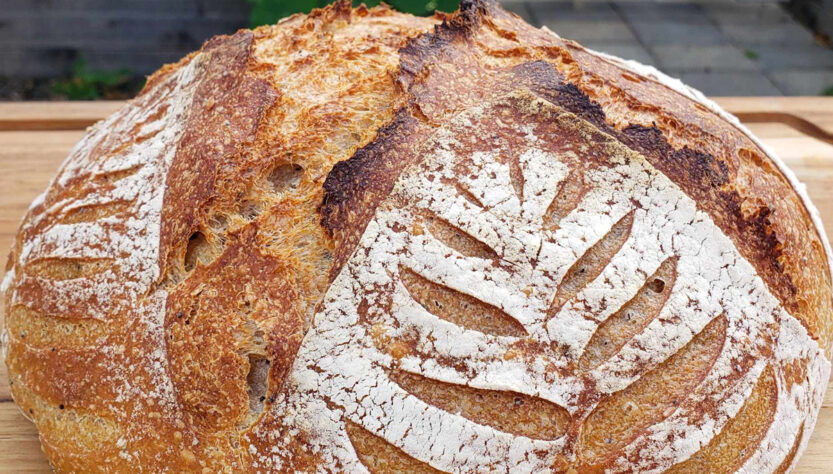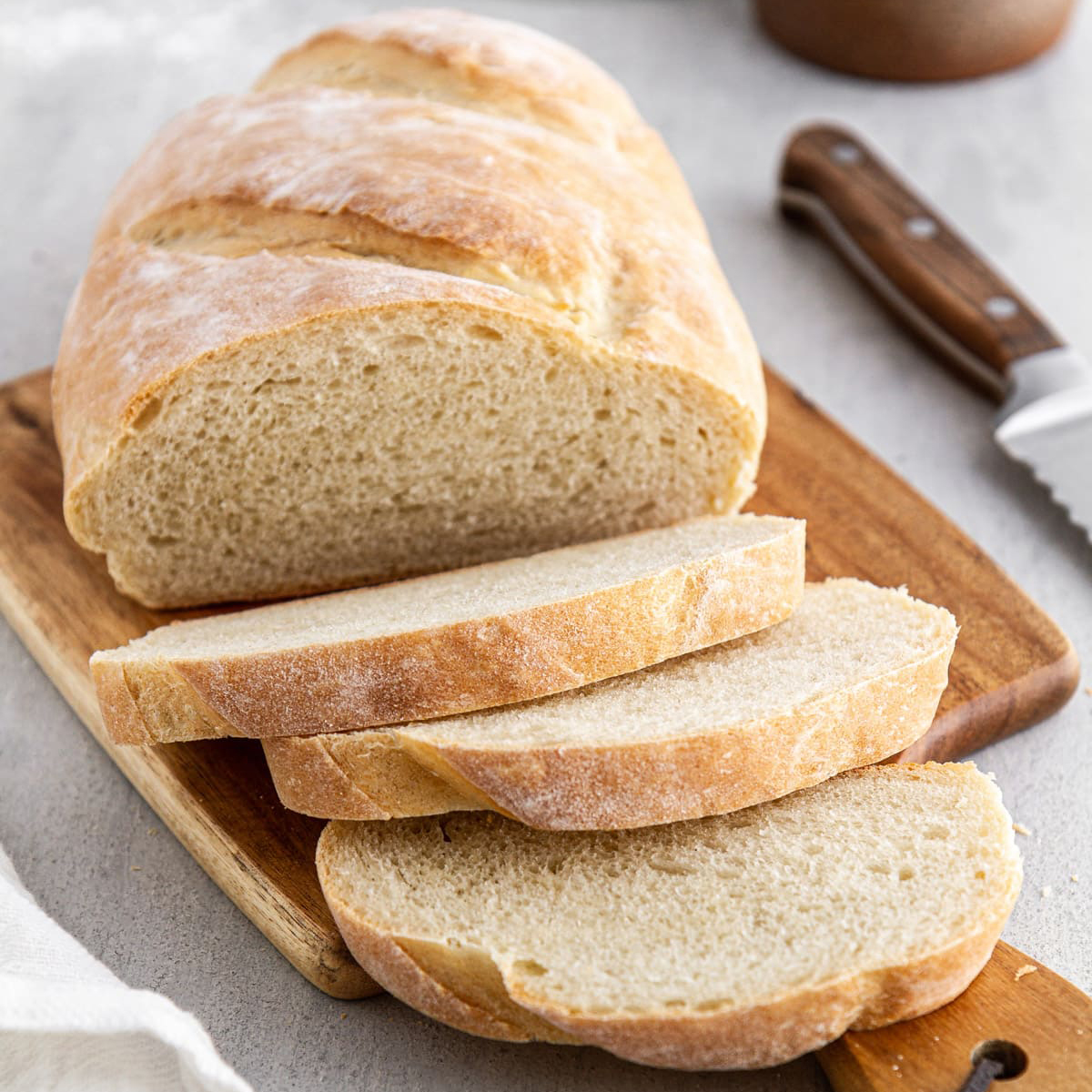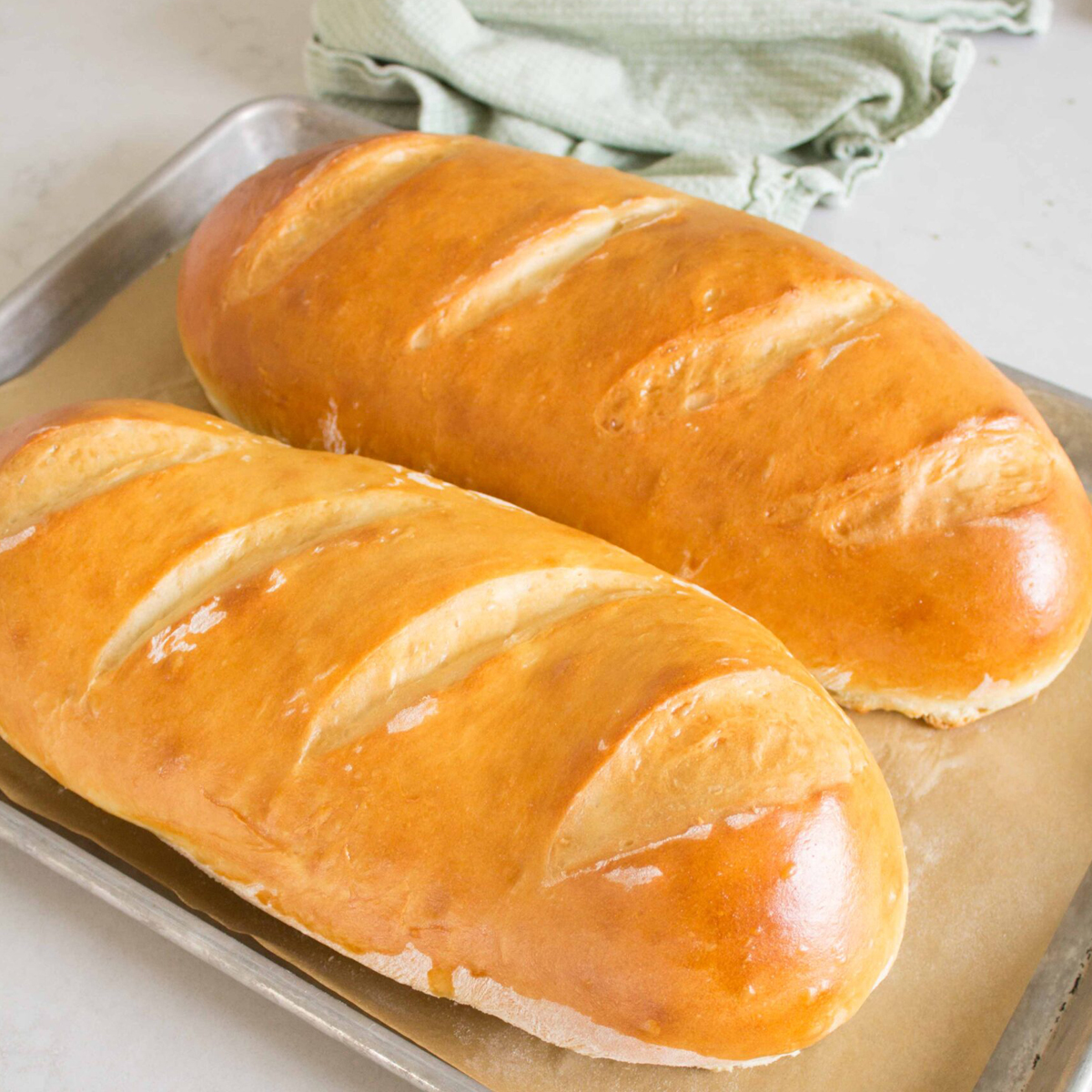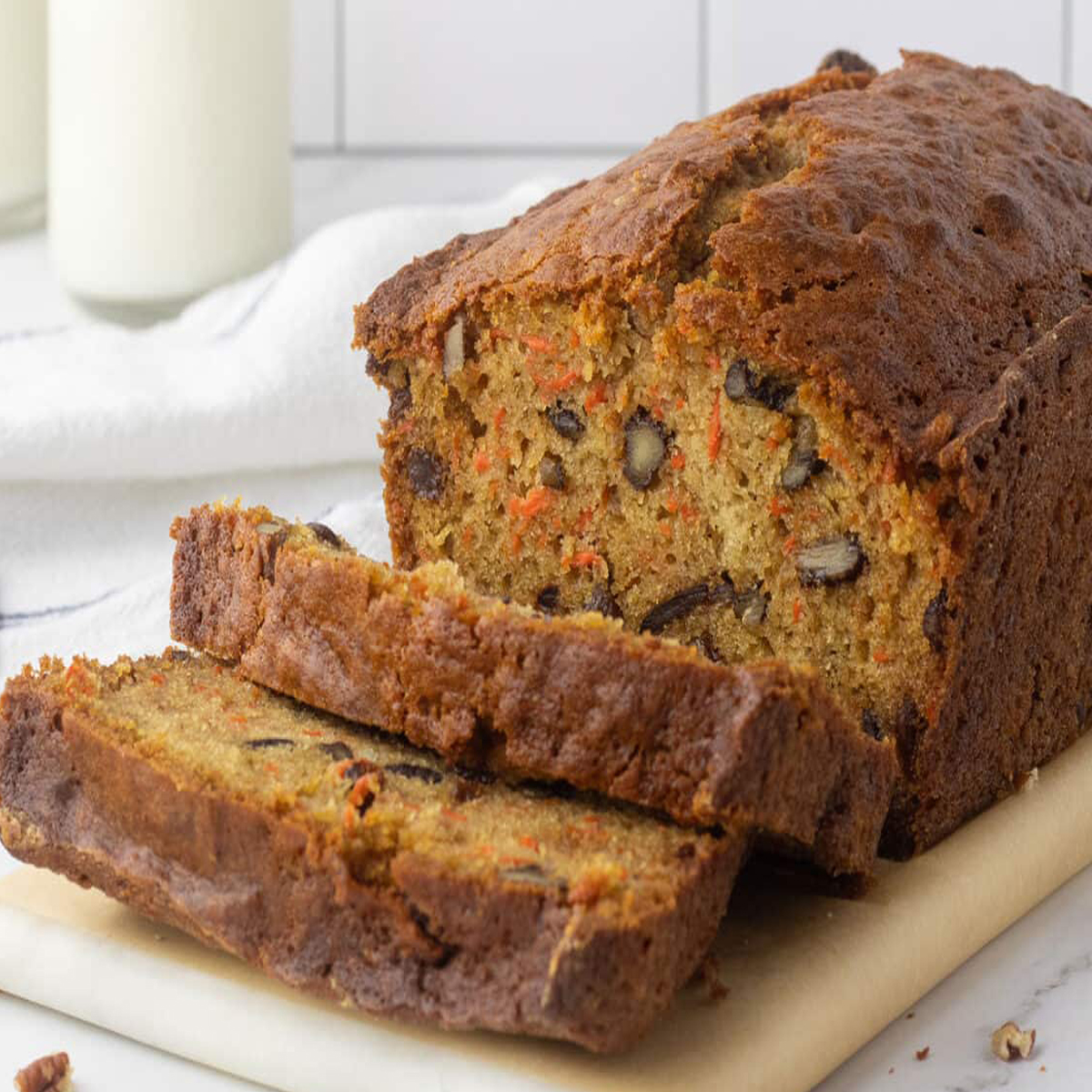Sourdough bread, with its rustic charm and unique tangy flavor, has been a beloved staple for centuries. This artisanal bread is more than just a delightful treat; it represents a time-honored tradition of bread-making that dates back to ancient times. Unlike conventional yeast-based bread, sourdough is leavened using a natural fermentation process, resulting in a distinct taste and texture that captures the hearts of bread enthusiasts worldwide.

The magic of sourdough lies in its starter—a living mixture of flour and water that captures wild yeast and beneficial bacteria from the environment. This natural leavening agent infuses the bread with a complex depth of flavors, a chewy crumb, and a crisp crust that sets it apart from commercial loaves. Sourdough bread is a testament to patience, as the dough undergoes a slow fermentation process that allows the flavors to develop fully.
Whether you’re a seasoned baker or embarking on your first sourdough journey, there’s a sense of accomplishment in crafting this time-tested bread from simple ingredients. Join the ranks of bread enthusiasts as we delve into the world of sourdough bread-making and discover the joy of creating a loaf that nourishes not only the body but also the soul.
What Is Sourdough Bread?
Sourdough bread is a type of bread made through a natural fermentation process using a sourdough starter, which is a mixture of flour and water that captures wild yeast and beneficial bacteria from the environment. This starter acts as a leavening agent, causing the bread dough to rise and develop its characteristic tangy flavor, chewy texture, and crisp crust.
Unlike traditional bread made with commercial yeast, sourdough bread relies solely on the wild yeast present in the starter to ferment the dough. The fermentation process can take several hours or even days, allowing the flavors to develop fully and resulting in a more complex and nuanced taste compared to regular bread.
Sourdough bread is believed to have ancient origins and has been a staple in various cultures for centuries. Its natural fermentation process and lack of added commercial yeast make it a popular choice for individuals seeking a more traditional and wholesome bread option.
This artisanal bread has gained popularity in recent years due to its unique flavor profile, nutritional benefits, and the satisfaction that comes from mastering the art of sourdough baking. With its rustic charm and timeless appeal, sourdough bread continues to capture the hearts and taste buds of bread enthusiasts around the world.
Why You Will Love Sourdough Bread Recipe?
- Unique Flavor Profile: Sourdough bread boasts a distinctive tangy flavor that sets it apart from ordinary bread. The natural fermentation process brings out complex and nuanced taste notes that are deeply satisfying to the palate.
- Artisanal and Homemade: Baking sourdough bread is an artisanal experience that allows you to connect with a time-honored tradition of bread-making. Crafting your own loaf from scratch is a rewarding and fulfilling process that adds a sense of accomplishment to your baking endeavors.
- Wholesome Ingredients: Sourdough bread is made using minimal, wholesome ingredients—flour, water, and salt—without any commercial yeast or additives. This simple and natural composition makes it a healthier option for those seeking pure and unprocessed bread.
- Gut-Friendly Fermentation: The natural fermentation process involved in making sourdough bread enhances its nutritional profile. The beneficial bacteria and enzymes formed during fermentation may improve digestion and make nutrients more accessible to the body.
- Versatility: Sourdough bread is incredibly versatile and can be enjoyed in various ways. It makes delightful sandwiches, excellent toast, and pairs well with dips, spreads, and hearty soups.
- Longer Shelf Life: Thanks to the natural acidity created during fermentation, sourdough bread tends to stay fresh for a longer time compared to conventional bread. This means less food waste and more time to savor your homemade creation.
- Connection to Tradition: Baking sourdough bread connects you to a rich history of bread-making that spans generations. Embrace the time-honored techniques and embrace the artistry of sourdough baking.
- Customizable: Once you master the basic sourdough bread recipe, you can get creative with variations. Add nuts, seeds, dried fruits, or herbs to customize the bread to your taste preferences.
- Community and Sharing: The sourdough community is a vibrant and supportive group of bakers who share tips, tricks, and their love for sourdough bread. Joining this community adds a social aspect to your baking journey.
- Self-Sufficiency: Learning to bake your own sourdough bread reduces dependence on store-bought options and empowers you to create nourishing food for yourself and your loved ones.
From the moment you take your first bite of homemade sourdough bread, you’ll experience the joy of the tangy, chewy, and delicious creation that you lovingly brought to life. Discover the magic of sourdough baking and embrace the timeless art of making this beloved bread from scratch.
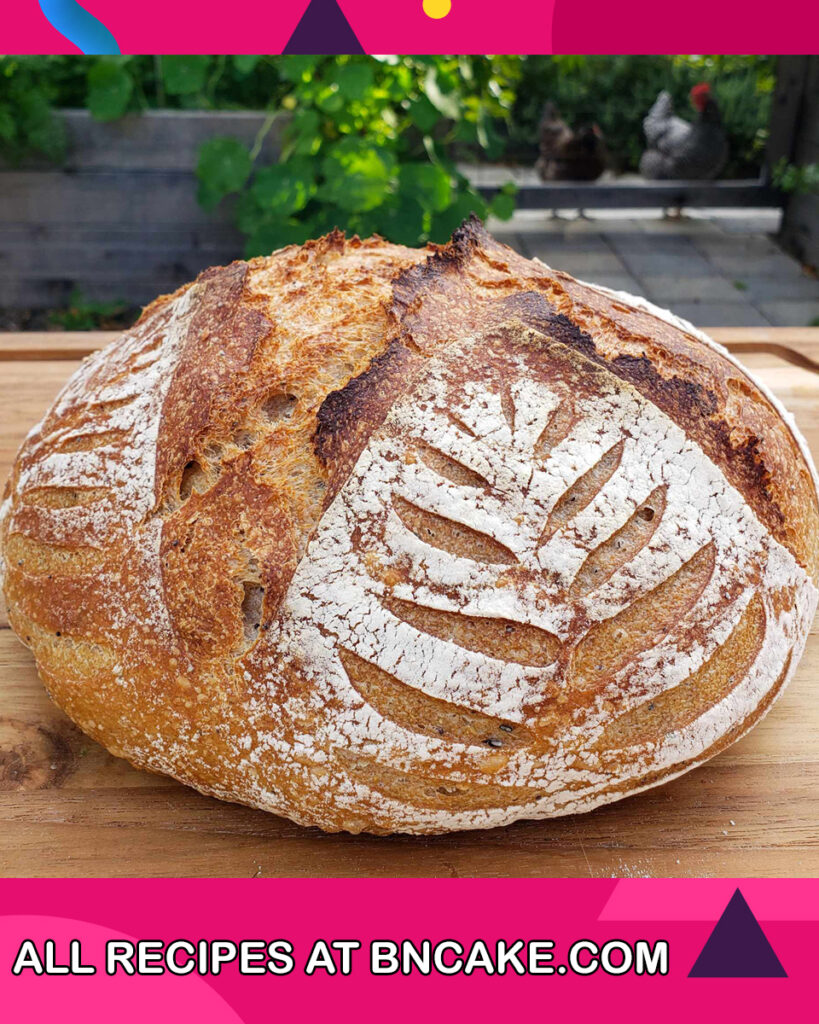
Ingredients For Sourdough Bread
- Sourdough Starter: 100g (about 1/2 cup) – A mixture of flour and water that has been fermented with wild yeast and bacteria to create a leavening agent.
- Bread Flour: 500g (about 4 cups) – High-protein flour, preferably unbleached, to give the bread structure and a good rise.
- Water: 300ml (about 1 1/4 cups) – Use filtered or non-chlorinated water for the best results.
- Salt: 10g (about 2 teaspoons) – Enhances the flavor of the bread and helps to control fermentation.
Optional Additions:
- Whole Wheat Flour: 50g (about 1/3 cup) – For a heartier and nuttier flavor, you can substitute a portion of bread flour with whole wheat flour.
- Seeds or Nuts: Add a handful of your favorite seeds (such as sesame, sunflower, or flax seeds) or nuts (like walnuts or pecans) to add texture and flavor.
Equipment Needed:
- Mixing bowls
- Kitchen scale (recommended for precise measurements)
- Wooden spoon or dough whisk
- Plastic or silicone dough scraper
- Banneton or proofing basket (for the final rise)
- Dutch oven or baking stone (for baking)
- Razor blade or lame (for scoring the bread)
Yield:
This recipe yields one loaf of sourdough bread.
Note:
The quantities mentioned above are for a basic sourdough bread recipe. Sourdough baking is an art, and minor adjustments to the hydration level, fermentation time, and other factors may be needed based on your specific environment and preferences. As you gain experience with sourdough baking, you can experiment with different flours, hydration levels, and fermentation times to create the perfect loaf that suits your taste and texture preferences. Enjoy the process of creating your own flavorful and crusty homemade sourdough bread!
How To Make Sourdough Bread
- In a mixing bowl, combine the sourdough starter, bread flour, and water. Mix with a wooden spoon or dough whisk until a shaggy dough forms. Let it rest for about 30 minutes (autolyse) to allow the flour to fully hydrate.
- Add the salt and optional whole wheat flour, seeds, or nuts to the dough. Mix well until all the ingredients are incorporated.
- Perform a series of stretch and folds to strengthen the dough. Cover the bowl and let it ferment at room temperature for several hours, depending on your sourdough starter’s activity and desired flavor development. Perform additional stretch and folds every 30 minutes during the initial fermentation.
- After bulk fermentation, shape the dough into a round loaf and place it into a floured banneton or proofing basket. Cover and let it undergo the final rise, or “proofing,” until the dough is visibly expanded and holds an indentation when gently pressed with a finger.
- Preheat your oven to 450°F (230°C) with a Dutch oven or baking stone inside. Once the oven is preheated, carefully transfer the proofed dough onto the hot Dutch oven or baking stone. Score the top of the dough with a razor blade or lame to control its expansion during baking.
- Bake the sourdough bread with the lid on (if using a Dutch oven) for about 20 minutes, then remove the lid and continue baking for another 20-25 minutes or until the crust is golden brown and the internal temperature reaches around 200°F (93°C).
- Remove the baked bread from the oven and let it cool on a wire rack for at least an hour before slicing.
Enjoy the flavorful and crusty goodness of your homemade Sourdough Bread. Slice it, toast it, and savor its delightful tangy taste and chewy texture.
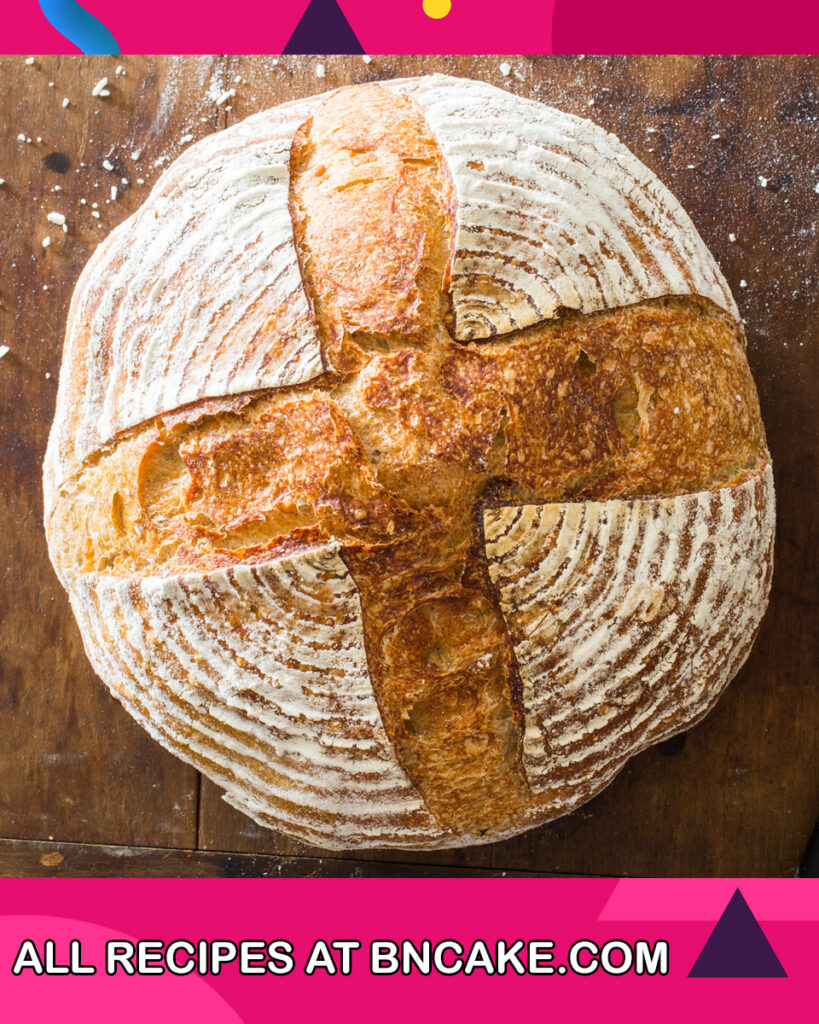
How To Serve Sourdough Bread
Serving Sourdough Bread is a delightful experience that allows you to fully appreciate its delicious flavor and texture. Here are some serving suggestions to enjoy your freshly baked sourdough bread:
- Warm and Fresh: Sourdough bread is at its best when it’s warm and fresh out of the oven. Allow the bread to cool slightly before slicing, and enjoy it with a pat of butter or a drizzle of olive oil.
- Simple Toast: Toasting slices of sourdough bread brings out its nutty flavor and adds a crispiness to the crust. Spread some jam, peanut butter, avocado, or your favorite toppings on the toast.
- Sandwiches: Use sourdough bread as a base for delicious sandwiches. Layer it with your favorite fillings, such as roasted vegetables, grilled chicken, cheese, lettuce, and condiments.
- Bruschetta: Create a classic bruschetta by toasting slices of sourdough bread and topping them with fresh tomatoes, basil, garlic, and a drizzle of balsamic glaze.
- Crostinis: Slice sourdough bread into small rounds, brush them with olive oil, and toast until crisp. Top with various toppings like cheese, cured meats, or tapenades to serve as elegant appetizers.
- Sourdough French Toast: Transform your sourdough bread into a delectable breakfast by making French toast. Dip slices into a mixture of eggs, milk (or plant-based milk for a vegan option), and cinnamon, then pan-fry until golden brown.
- Sourdough Bread Bowl: Hollow out a round loaf of sourdough bread and fill it with your favorite soup or dip. The bread bowl adds a rustic touch and is edible, making it perfect for serving at gatherings.
- Dipping with Olive Oil and Balsamic Vinegar: Slice the bread into thick pieces, and serve with a small dish of extra virgin olive oil and balsamic vinegar for dipping.
- Accompaniment to Cheese Platters: Slice the sourdough bread into thin pieces and serve it alongside a selection of cheeses and fruits for a delightful cheese platter.
- Panini or Grilled Sandwiches: Use slices of sourdough bread for paninis or grilled sandwiches. Fill them with your favorite ingredients and grill until golden and melty.
No matter how you choose to serve it, the versatility and rich flavor of sourdough bread will enhance any meal and delight your taste buds. Enjoy the wonderful world of sourdough bread and explore the many delicious ways to savor this timeless favorite!
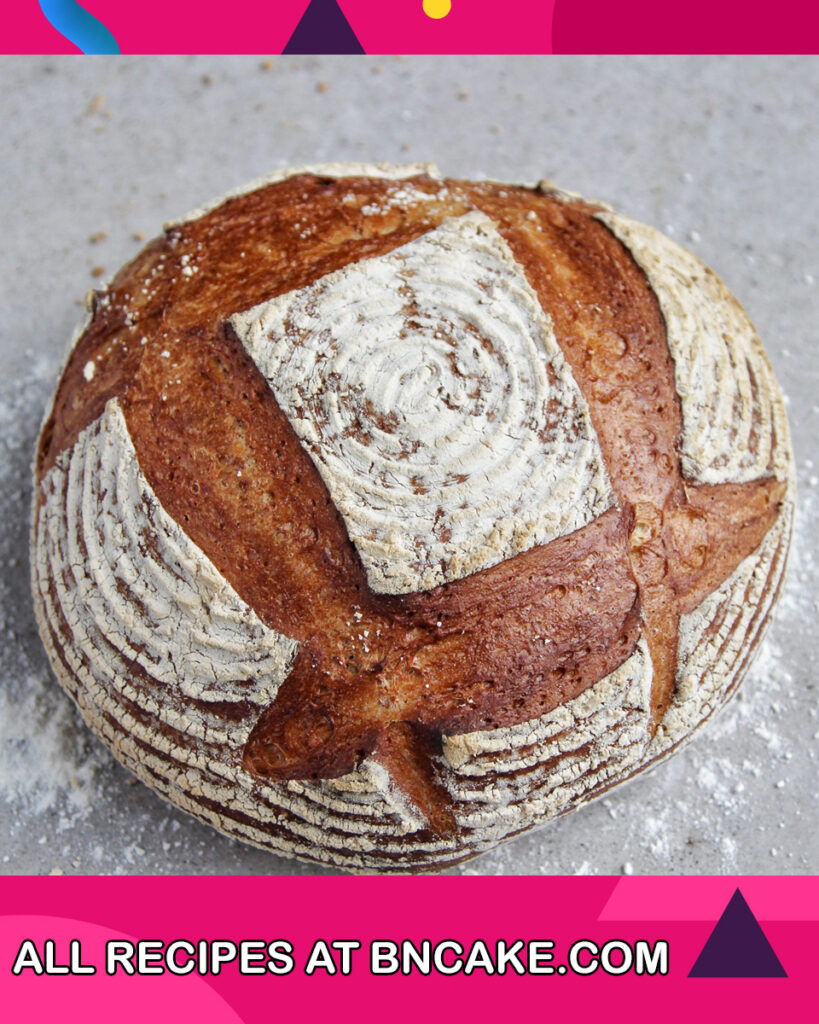
How To Store Sourdough Bread
Storing Sourdough Bread properly is essential to maintain its freshness, crust, and flavor. Here are some guidelines on how to store sourdough bread to keep it at its best:
- Cooling Process: Allow the freshly baked sourdough bread to cool completely at room temperature before storing. This prevents condensation from forming inside the bag, which can make the crust soggy.
- Wrap in a Cloth or Paper Bag: To maintain the crust’s texture, store the cooled sourdough bread in a cloth bread bag or wrap it in a clean kitchen towel or paper bag. Avoid using airtight plastic bags or containers as they can trap moisture and cause the bread to become stale quickly.
- Room Temperature: If you plan to consume the bread within 1-2 days, you can keep it at room temperature. Place the wrapped loaf in a breadbox or a bread drawer to protect it from direct sunlight.
- Refrigeration: For longer storage (up to 1 week), you can refrigerate the wrapped sourdough bread. The refrigerator helps to slow down the staling process. However, refrigeration may cause the crust to lose some crispiness.
- Freezing: To store sourdough bread for an extended period (up to 3 months), freeze it. Slice the bread before freezing for easier portioning. Wrap individual slices or the whole loaf tightly in plastic wrap, then place them in a resealable freezer bag or an airtight container.
- Thawing Frozen Bread: When ready to use frozen sourdough bread, thaw it at room temperature in its wrapping to prevent moisture loss. You can also reheat slices in a toaster or oven for a few minutes to revive the crust.
- Reinvigorating Stale Bread: If your sourdough bread becomes slightly stale, you can refresh it by spraying the crust with a little water and then reheating it in a 350°F (175°C) oven for 5-10 minutes.
Important Note: Sourdough bread is best consumed within the first 2-3 days of baking when it’s at its freshest and most flavorful. As it lacks the preservatives found in commercial bread, it naturally has a shorter shelf life.
By following these storage tips, you can enjoy your sourdough bread for longer while preserving its delightful taste and texture. Remember that sourdough bread is at its peak when freshly baked, so try to enjoy it as soon as possible after baking for the ultimate sourdough experience!

If You Love This Recipe Try These Out!
FAQs and Troubleshooting about Sourdough Bread
1. Why is my sourdough bread not rising properly?
- There could be several reasons for poor rise, such as an inactive or weak sourdough starter, not giving the dough enough time to ferment, or using old or low-quality flour. Ensure your starter is active and bubbly, and consider adjusting the fermentation time based on your room temperature and starter strength.
2. Why does my sourdough bread have a dense texture?
- A dense texture can result from insufficient gluten development during mixing or shaping, overproofing the dough, or using too much whole grain flour, which hinders gluten formation. Ensure proper mixing and shaping techniques, and experiment with different flour ratios to find the right balance.
3. How do I know when my sourdough bread is fully proofed?
- Proper proofing is crucial for a well-risen loaf. The dough should be visibly expanded, hold an indentation when gently pressed with a finger, and show some small bubbles on the surface. If the dough has doubled in size, it is likely ready to bake.
4. Why is my sourdough bread too sour or not sour enough?
- The level of sourness depends on the fermentation time and temperature. Longer fermentation at cooler temperatures generally results in a more pronounced sour flavor. Adjust the proofing time and temperature to achieve your desired level of sourness.
5. How can I make my sourdough crust crispier?
- To achieve a crispy crust, ensure that the oven is preheated properly before baking. Steam the oven during the first 10-15 minutes of baking by placing a pan of hot water in the oven. Additionally, avoid wrapping the bread in plastic while it’s still warm, as this can soften the crust.
6. My sourdough bread is gummy inside. What went wrong?
- A gummy or undercooked interior can occur if the bread is not fully baked. Ensure that the internal temperature of the bread reaches around 200°F (93°C) before removing it from the oven.
7. Can I use whole wheat flour or other grains in my sourdough bread?
- Yes, you can experiment with different flours and grains to add flavor and texture. However, whole grain flours may require adjustments in hydration levels and fermentation times, as they absorb more water and ferment differently.
8. How can I prevent my sourdough bread from sticking to the banneton or proofing basket?
- Use a light dusting of flour or rice flour inside the banneton or proofing basket to prevent sticking. Alternatively, line the basket with a clean cloth or a layer of parchment paper before placing the dough.
9. How do I fix a sourdough loaf with an uneven rise?
- An uneven rise may result from improper shaping or uneven dough distribution. Focus on even shaping, and consider redistributing the dough within the banneton or proofing basket before the final rise.
10. Can I use a regular loaf pan to bake sourdough bread?
- Yes, you can use a loaf pan to bake sourdough bread. However, the crust may not be as crispy as when using a Dutch oven or baking stone. To achieve a crispy crust, remove the bread from the loaf pan during the last few minutes of baking and place it directly on the oven rack.
Remember that sourdough baking is a learning process, and don’t be discouraged by any challenges you encounter. Embrace experimentation and make adjustments to achieve the perfect loaf that suits your taste and preferences.

Note about Sourdough Bread
Welcome to the delightful world of sourdough bread! This ancient and artisanal bread has a unique taste, texture, and character that captures the hearts of bread enthusiasts around the globe. As you embark on your sourdough baking journey, here are some key points to keep in mind:
1. Embrace Patience: Sourdough bread is a labor of love and requires time and patience. From nurturing your sourdough starter to allowing the dough to ferment and rise, each step contributes to the distinctive flavors and aromas of the final loaf. Enjoy the process and savor the anticipation of creating a delicious masterpiece.
2. The Power of Wild Yeast: Unlike commercial yeast, sourdough relies on wild yeast and lactobacilli present in the starter. These microorganisms work together to leaven the bread and create its tangy taste. Nurturing a lively and active starter is the heart of successful sourdough baking.
3. Embrace Imperfections: Sourdough baking is an art rather than an exact science. Each loaf may vary in appearance, flavor, and texture based on various factors like fermentation times, temperatures, and flour types. Embrace the uniqueness of each batch, and remember that even minor imperfections add character to your creations.
4. Adjustments and Experiments: Feel free to experiment with flours, hydration levels, and fermentation times to find the perfect formula that suits your preferences. Don’t be afraid to make adjustments and learn from each bake.
5. Consistency is Key: Sourdough bread baking can be affected by environmental factors like temperature and humidity. Keeping a baking journal and recording your processes can help you achieve more consistent results.
6. Sharing the Joy: One of the pleasures of sourdough baking is sharing your creations with others. Whether it’s slicing a warm loaf for your family or gifting a beautifully baked bread to a friend, the joy of sharing your love for sourdough is truly rewarding.
7. A Nourishing Tradition: Sourdough bread is not just a delectable treat; it represents a long-standing tradition of breadmaking passed down through generations. As you continue this tradition, you become part of a rich history of bakers who have cherished the art of sourdough.
Remember that every sourdough journey is a learning experience, and each loaf you create is a testament to your dedication and passion. So, roll up your sleeves, dive into the wonderful world of sourdough bread, and let the magic of wild fermentation unfold before your eyes. Happy baking!
Nutrition Information
Calories: 250 kcal, Carbohydrates: 51g, Sugars: 0.4g, Dietary Fiber: 2.2g, Fat: 1g, Saturated Fat: 0.2g, Trans Fat: 0g, Protein: 8g, Cholesterol: 0mg, Sodium: 625mg, Potassium: 95mg, Calcium: 10mg, Iron: 2mg, Vitamin D: 0IU, Vitamin C: 0mg
Note: The nutrition information provided is a general estimate and can vary depending on the specific recipe and ingredients used to make the sourdough bread. The nutritional content may also change based on the type of flour, hydration levels, and any additional ingredients or variations incorporated in the recipe. For accurate nutritional information, it’s recommended to calculate the values based on the specific ingredients used in your homemade sourdough bread recipe.

